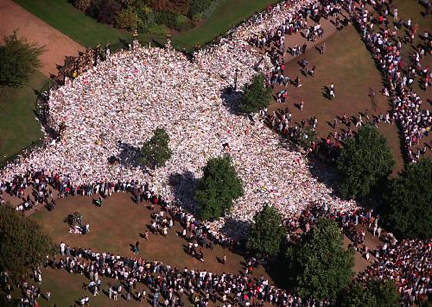
Memorial in Norway for recent tragedy
The San Francisco journalist Zahid Sadar and I are at a bar in Glen Park. We’re discussing death when Zahid mentions a book he’s excited about: David Rockwell’s Spectacle.
The two ideas come together like a sandwich, and we soon begin discussing spectacles born out of our national tragedies. I serendipitously bring up the fact that I worked at WalkerGroup/CNI in the 80’s, equating it to the Rockwell Group of its day. I have no idea I’ve just predicted a party invite that is entering my email box at approximately this moment.

Laptop perched on the bar, I web search Spectacle while Zahid orders us each a glass of wine. The word Spectacle appears in bold black; it is a visually enticing cover, as would be expected of any Bruce Mau design.
Zahid and I click through what David Rockwell has compiled as a stunning, provocative book of public Spectacles spanning around the world. In our general region alone, images range from massive Las Vegas firework displays to the annual Burning Man festival, where an entire city of art and pleasure is created and disassembled for a weeklong event. We see daunting rows of floating pilgrims who have traveled to the holy shores of the Ganges in India for the Kumbh Mela every twelve years — and much more.

Hindus Kumbh Mela celebration on the Ganges
David Rockwell has captured far-flung and fleeting human spectacles for us to marvel at. All the spectacles in his book are planned: intentionally created and experienced by willing participants, usually for pleasure.
On the other hand, spectacles that arise from tragedy are different — we call them memorials. They are created organically, driven by the creativity of collective bystanders randomly brought together by disaster. Each individual is so inexplicably moved by the emotions and meaning of death and loss that they participate in a sort of organized chaos in order to cope. We learn that tragedy bonds people and creates meaningful order that may last many lifetimes.
Memoriam spectacles become a kind of cathartic, spontaneous moment in which people come together in spite of a “Black Swan occurrence.” There is no creative risk taking because the risk has already taken place — without warning or logic — having dealt its swift blow. The resulting spectacle is profound, to always be remembered.

9/11 Memorial at Inwood Park
Out of this grief and chaos grows the most beautiful, organic and singular of spectacle moments. Complete strangers galvanize and, without any discussion, design a truly peaceful and awe-inspiring memorial. A memoriam driven by those in pain and created for all those suffering, with the sole purpose of remembrance and healing.
These grand spectacles of memoriam are a recent phenomenon of contemporary society. Previous tragedies, like the shooting of JFK in 1963, were more singular, isolated events. Individuals healed alone in front of a TV, watching from afar a traditional memorial they had no opportunity to personally participate in.

Flowers for Diana at Kensington Palace
Today, those touched by a universal event choose to come together to create their own contemporary way to express grief. A good example is the death of Princess Di, when the masses forced their vision on the monarchy; they empowered themselves through a spectacle which fully expressed their sadness.
David Rockwell makes a comment that is universal to both types of spectacles, pleasure and tragedy: “The creation of something impermanent adds a level of poignancy that relates to human life — we’re not around forever.”
I arrive home from my evening with Zahid and open my email to find a completely unexpected Evite to the one and only WalkerGroup/CNI reunion party in NYC… as I scroll through the long list of former employees, I see David Rockwell’s name. Of course! Life is full of unexpected surprises, connections and spectacles — be they small or of the greatest human magnitude.


International Candle Light Vigils for Japanese quake victims

 David Rockwell Amasses a Book of Spectacles
David Rockwell Amasses a Book of Spectacles


 First the Wealth Gap, Now the U.S. Has a Growing Health Gap
First the Wealth Gap, Now the U.S. Has a Growing Health Gap
 How to Comfort A Dying Loved One
How to Comfort A Dying Loved One
 Our Annual Seven Holiday Gifts for Someone Who Is Grieving, 2024 Edition
Our Annual Seven Holiday Gifts for Someone Who Is Grieving, 2024 Edition














